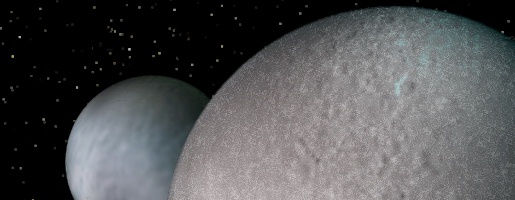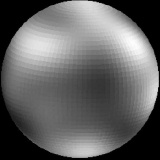 |
|||
|
View
across Pluto towards Charon.
|
|||
| THE SURFACE OF PLUTO | |||
| Analysis of the light reflected from Pluto's surface reveals methane ice. The methane crust makes Pluto highly reflective. The surface has an albedo of 0.3 to 0.5, our Moon by comparison has an albedo of 0.1. In some observations of Pluto's surface, it is described as being slightly reddish. This is thought to indicate that the ice is contaminated with other materials. | |||
| Light and dark regions on Pluto were mapped during a phase in the 1980's when their orbits were edge on with respect to Earth and the two could be seen to eclipse one another periodically. More recently light and dark regions were observed in slightly more detail, using the Hubble Space Telescope. | |||
 The Hubble Space Telescope provides the best telescopic view of Pluto. The bright areas are interpreted as nitrogen ice with some methane and some carbon monoxide. The dark areas contain unidentified compounds, possibly primordial organic materials or the products of photochemical reactions driven by cosmic rays. |
 Hubble Space Telescope view of Pluto's surface. No surface features can be identified but there are markings which have been observed consistently. The south pole of Pluto is brighter, more reflective than the rest of the planet. |
 Multiple Hubble Space Telescope images have been combined to reveal Pluto's surface markings. |
|
| Because the surface temperature is very low - only about 35 to 50 K above absolute zero (about -240oC to -220oC) - any gases such as methane nitrogen or carbon monoxide exist as ice. That is, until Pluto reaches perihelion. When it does so, heat from the Sun vapourises the gases. | |||
| There is a convincing argument for Pluto being quite well differentiated. If there was rock mixed in with the outer layers, then with each pass of the Sun rock and debris would accumulate on the surface as the ice was vapourised. This would eventually insulate the planet against further loss of volatile material. Because we can still detect an icy surface, this evidently has not happened. | |||
| Pluto may therefore have no craters. On its pass close to the Sun the evaporation of the surface methane erases them. So although it has bright and dark regions, these are chemical or relate to composition of the surface, rather than topographical or geological structures. | |||
|
|
|||